Organizational Culture and Employee Performance at ASDA
VerifiedAdded on 2023/01/12
|10
|2623
|87
Project
AI Summary
This project investigates the influence of organizational culture on employee performance and satisfaction, focusing on the retail sector and specifically on ASDA. The project begins with an introduction outlining the importance of organizational culture and its impact on employee behavior, motivation, and productivity. It sets aims and objectives to examine the concept of organizational culture, its relationship with employee performance, major challenges in maintaining a good culture, and strategies for improvement. A literature review explores the concept of organizational culture, its impact on worker performance, and the challenges faced by organizations like ASDA in promoting a positive culture. The research methodology section outlines the research type (qualitative), approach (inductive), philosophy (interpretivism), data collection methods (primary and secondary), sampling (20 ASDA employees), data analysis (thematic), and ethical considerations. The project aims to provide insights into how organizational culture affects employee outcomes and offers strategies for ASDA to enhance its culture and improve employee performance.

PROJECT
Paraphrase This Document
Need a fresh take? Get an instant paraphrase of this document with our AI Paraphraser

Table of Contents
INTRODUCTION...........................................................................................................................2
LITERATURE REVIEW................................................................................................................3
Concept of organizational culture................................................................................................3
Relationship between organizational culture and worker’s performance....................................4
Major challenges being faced by ADSA in maintaining & promoting good organizational
culture...........................................................................................................................................5
RESEARCH METHODOLODY....................................................................................................5
TIMEPLAN.....................................................................................................................................7
REFERENCES................................................................................................................................8
INTRODUCTION...........................................................................................................................2
LITERATURE REVIEW................................................................................................................3
Concept of organizational culture................................................................................................3
Relationship between organizational culture and worker’s performance....................................4
Major challenges being faced by ADSA in maintaining & promoting good organizational
culture...........................................................................................................................................5
RESEARCH METHODOLODY....................................................................................................5
TIMEPLAN.....................................................................................................................................7
REFERENCES................................................................................................................................8
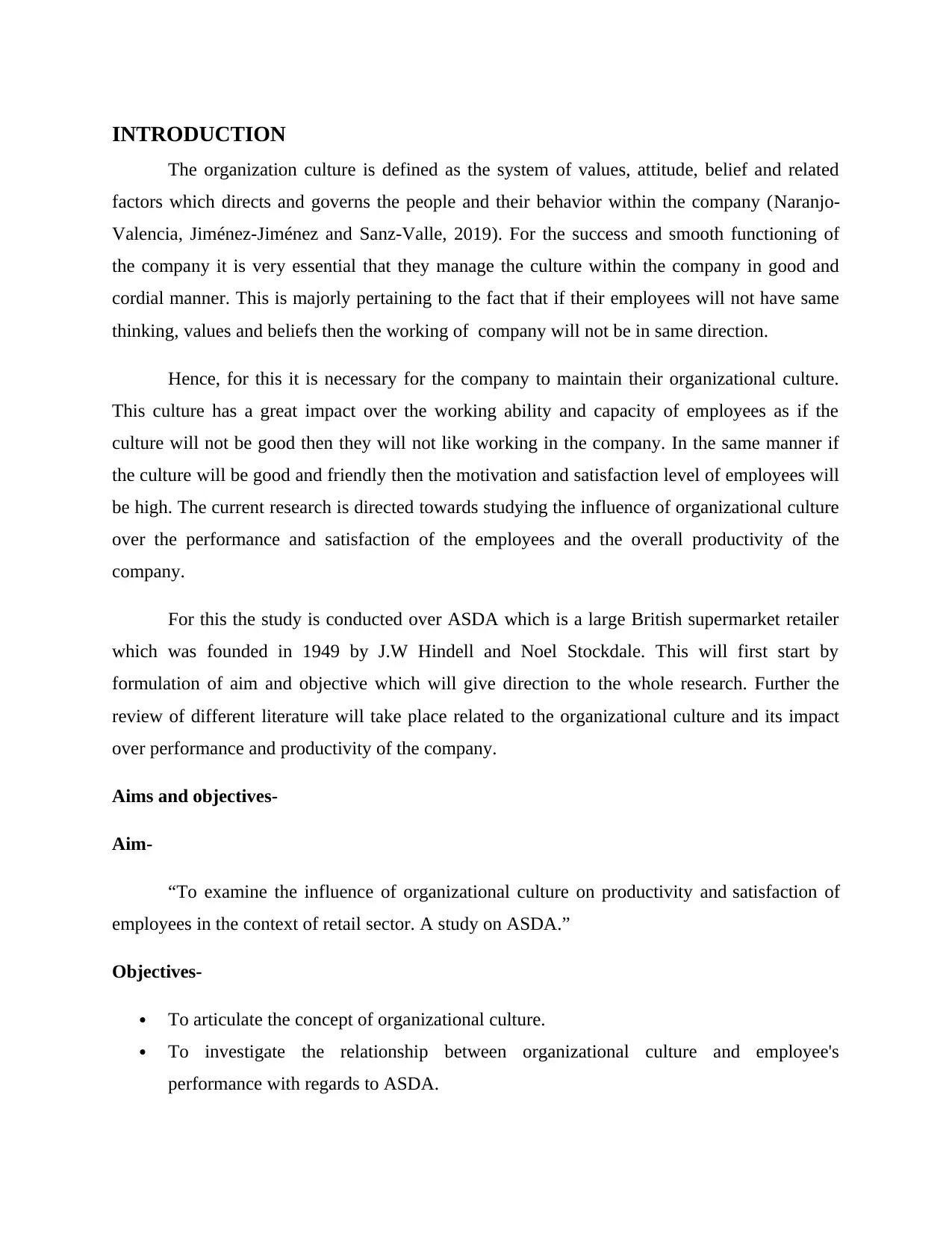
INTRODUCTION
The organization culture is defined as the system of values, attitude, belief and related
factors which directs and governs the people and their behavior within the company (Naranjo-
Valencia, Jiménez-Jiménez and Sanz-Valle, 2019). For the success and smooth functioning of
the company it is very essential that they manage the culture within the company in good and
cordial manner. This is majorly pertaining to the fact that if their employees will not have same
thinking, values and beliefs then the working of company will not be in same direction.
Hence, for this it is necessary for the company to maintain their organizational culture.
This culture has a great impact over the working ability and capacity of employees as if the
culture will not be good then they will not like working in the company. In the same manner if
the culture will be good and friendly then the motivation and satisfaction level of employees will
be high. The current research is directed towards studying the influence of organizational culture
over the performance and satisfaction of the employees and the overall productivity of the
company.
For this the study is conducted over ASDA which is a large British supermarket retailer
which was founded in 1949 by J.W Hindell and Noel Stockdale. This will first start by
formulation of aim and objective which will give direction to the whole research. Further the
review of different literature will take place related to the organizational culture and its impact
over performance and productivity of the company.
Aims and objectives-
Aim-
“To examine the influence of organizational culture on productivity and satisfaction of
employees in the context of retail sector. A study on ASDA.”
Objectives-
To articulate the concept of organizational culture.
To investigate the relationship between organizational culture and employee's
performance with regards to ASDA.
The organization culture is defined as the system of values, attitude, belief and related
factors which directs and governs the people and their behavior within the company (Naranjo-
Valencia, Jiménez-Jiménez and Sanz-Valle, 2019). For the success and smooth functioning of
the company it is very essential that they manage the culture within the company in good and
cordial manner. This is majorly pertaining to the fact that if their employees will not have same
thinking, values and beliefs then the working of company will not be in same direction.
Hence, for this it is necessary for the company to maintain their organizational culture.
This culture has a great impact over the working ability and capacity of employees as if the
culture will not be good then they will not like working in the company. In the same manner if
the culture will be good and friendly then the motivation and satisfaction level of employees will
be high. The current research is directed towards studying the influence of organizational culture
over the performance and satisfaction of the employees and the overall productivity of the
company.
For this the study is conducted over ASDA which is a large British supermarket retailer
which was founded in 1949 by J.W Hindell and Noel Stockdale. This will first start by
formulation of aim and objective which will give direction to the whole research. Further the
review of different literature will take place related to the organizational culture and its impact
over performance and productivity of the company.
Aims and objectives-
Aim-
“To examine the influence of organizational culture on productivity and satisfaction of
employees in the context of retail sector. A study on ASDA.”
Objectives-
To articulate the concept of organizational culture.
To investigate the relationship between organizational culture and employee's
performance with regards to ASDA.
⊘ This is a preview!⊘
Do you want full access?
Subscribe today to unlock all pages.

Trusted by 1+ million students worldwide

To investigate the major difficulties being faced by ASDA in promoting and maintaining
good organizational culture.
To recommend strategies to ASDA that contributes in indulging prominent culture within
ASDA and enhancing employee's performance.
Research questions
What is the concept of organization culture?
What is the relation between organization culture and performance of employees with
regards to ASDA?
What are the major difficulties faced by ASDA in promoting and maintaining good
organizational culture?
Rationale
The management of the organization culture is very essential and important for the
company in attaining success and aims of the business. This is the major issue which is being
faced by much different organization as if the culture will not be maintained properly then the
employees will not work up to their fullest potential (Arditi, Nayak and Damci, 2017). Thus, the
major reason for the selection of this research topic is to find some strategies for the maintenance
of the organization culture and to improve the performance of the employees. Also, another
major important reason for the selection of the organizational culture is the personal and
academic interest of the researcher.
LITERATURE REVIEW
Concept of organizational culture
According to Idowu, (2017) organizational culture is defined as underlying assumptions,
ways, values and beliefs of interacting that support to good social as well as psychological
environment of companies. It includes an company’s expectations, philosophy, experiences and
values that direct individual behavior. It is expressed in person self image, interactions,
interactions and inner working with outside world and the future expectations. Culture is based
on beliefs, attitudes, customs, unwritten and written rules that can be developed over time and
are focused valid. It also includes vision, norms, symbols, values, language, habits and
good organizational culture.
To recommend strategies to ASDA that contributes in indulging prominent culture within
ASDA and enhancing employee's performance.
Research questions
What is the concept of organization culture?
What is the relation between organization culture and performance of employees with
regards to ASDA?
What are the major difficulties faced by ASDA in promoting and maintaining good
organizational culture?
Rationale
The management of the organization culture is very essential and important for the
company in attaining success and aims of the business. This is the major issue which is being
faced by much different organization as if the culture will not be maintained properly then the
employees will not work up to their fullest potential (Arditi, Nayak and Damci, 2017). Thus, the
major reason for the selection of this research topic is to find some strategies for the maintenance
of the organization culture and to improve the performance of the employees. Also, another
major important reason for the selection of the organizational culture is the personal and
academic interest of the researcher.
LITERATURE REVIEW
Concept of organizational culture
According to Idowu, (2017) organizational culture is defined as underlying assumptions,
ways, values and beliefs of interacting that support to good social as well as psychological
environment of companies. It includes an company’s expectations, philosophy, experiences and
values that direct individual behavior. It is expressed in person self image, interactions,
interactions and inner working with outside world and the future expectations. Culture is based
on beliefs, attitudes, customs, unwritten and written rules that can be developed over time and
are focused valid. It also includes vision, norms, symbols, values, language, habits and
Paraphrase This Document
Need a fresh take? Get an instant paraphrase of this document with our AI Paraphraser
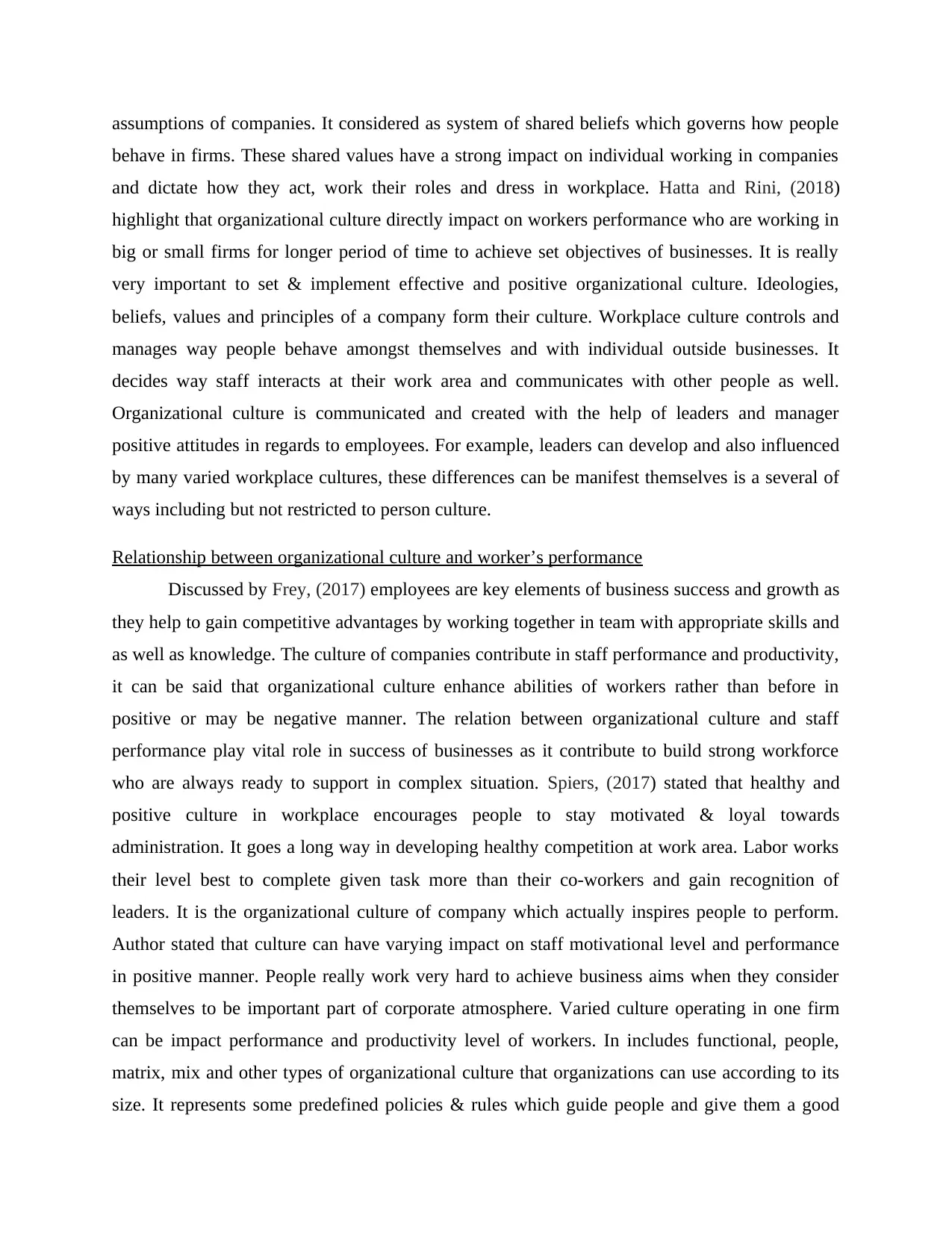
assumptions of companies. It considered as system of shared beliefs which governs how people
behave in firms. These shared values have a strong impact on individual working in companies
and dictate how they act, work their roles and dress in workplace. Hatta and Rini, (2018)
highlight that organizational culture directly impact on workers performance who are working in
big or small firms for longer period of time to achieve set objectives of businesses. It is really
very important to set & implement effective and positive organizational culture. Ideologies,
beliefs, values and principles of a company form their culture. Workplace culture controls and
manages way people behave amongst themselves and with individual outside businesses. It
decides way staff interacts at their work area and communicates with other people as well.
Organizational culture is communicated and created with the help of leaders and manager
positive attitudes in regards to employees. For example, leaders can develop and also influenced
by many varied workplace cultures, these differences can be manifest themselves is a several of
ways including but not restricted to person culture.
Relationship between organizational culture and worker’s performance
Discussed by Frey, (2017) employees are key elements of business success and growth as
they help to gain competitive advantages by working together in team with appropriate skills and
as well as knowledge. The culture of companies contribute in staff performance and productivity,
it can be said that organizational culture enhance abilities of workers rather than before in
positive or may be negative manner. The relation between organizational culture and staff
performance play vital role in success of businesses as it contribute to build strong workforce
who are always ready to support in complex situation. Spiers, (2017) stated that healthy and
positive culture in workplace encourages people to stay motivated & loyal towards
administration. It goes a long way in developing healthy competition at work area. Labor works
their level best to complete given task more than their co-workers and gain recognition of
leaders. It is the organizational culture of company which actually inspires people to perform.
Author stated that culture can have varying impact on staff motivational level and performance
in positive manner. People really work very hard to achieve business aims when they consider
themselves to be important part of corporate atmosphere. Varied culture operating in one firm
can be impact performance and productivity level of workers. In includes functional, people,
matrix, mix and other types of organizational culture that organizations can use according to its
size. It represents some predefined policies & rules which guide people and give them a good
behave in firms. These shared values have a strong impact on individual working in companies
and dictate how they act, work their roles and dress in workplace. Hatta and Rini, (2018)
highlight that organizational culture directly impact on workers performance who are working in
big or small firms for longer period of time to achieve set objectives of businesses. It is really
very important to set & implement effective and positive organizational culture. Ideologies,
beliefs, values and principles of a company form their culture. Workplace culture controls and
manages way people behave amongst themselves and with individual outside businesses. It
decides way staff interacts at their work area and communicates with other people as well.
Organizational culture is communicated and created with the help of leaders and manager
positive attitudes in regards to employees. For example, leaders can develop and also influenced
by many varied workplace cultures, these differences can be manifest themselves is a several of
ways including but not restricted to person culture.
Relationship between organizational culture and worker’s performance
Discussed by Frey, (2017) employees are key elements of business success and growth as
they help to gain competitive advantages by working together in team with appropriate skills and
as well as knowledge. The culture of companies contribute in staff performance and productivity,
it can be said that organizational culture enhance abilities of workers rather than before in
positive or may be negative manner. The relation between organizational culture and staff
performance play vital role in success of businesses as it contribute to build strong workforce
who are always ready to support in complex situation. Spiers, (2017) stated that healthy and
positive culture in workplace encourages people to stay motivated & loyal towards
administration. It goes a long way in developing healthy competition at work area. Labor works
their level best to complete given task more than their co-workers and gain recognition of
leaders. It is the organizational culture of company which actually inspires people to perform.
Author stated that culture can have varying impact on staff motivational level and performance
in positive manner. People really work very hard to achieve business aims when they consider
themselves to be important part of corporate atmosphere. Varied culture operating in one firm
can be impact performance and productivity level of workers. In includes functional, people,
matrix, mix and other types of organizational culture that organizations can use according to its
size. It represents some predefined policies & rules which guide people and give them a good
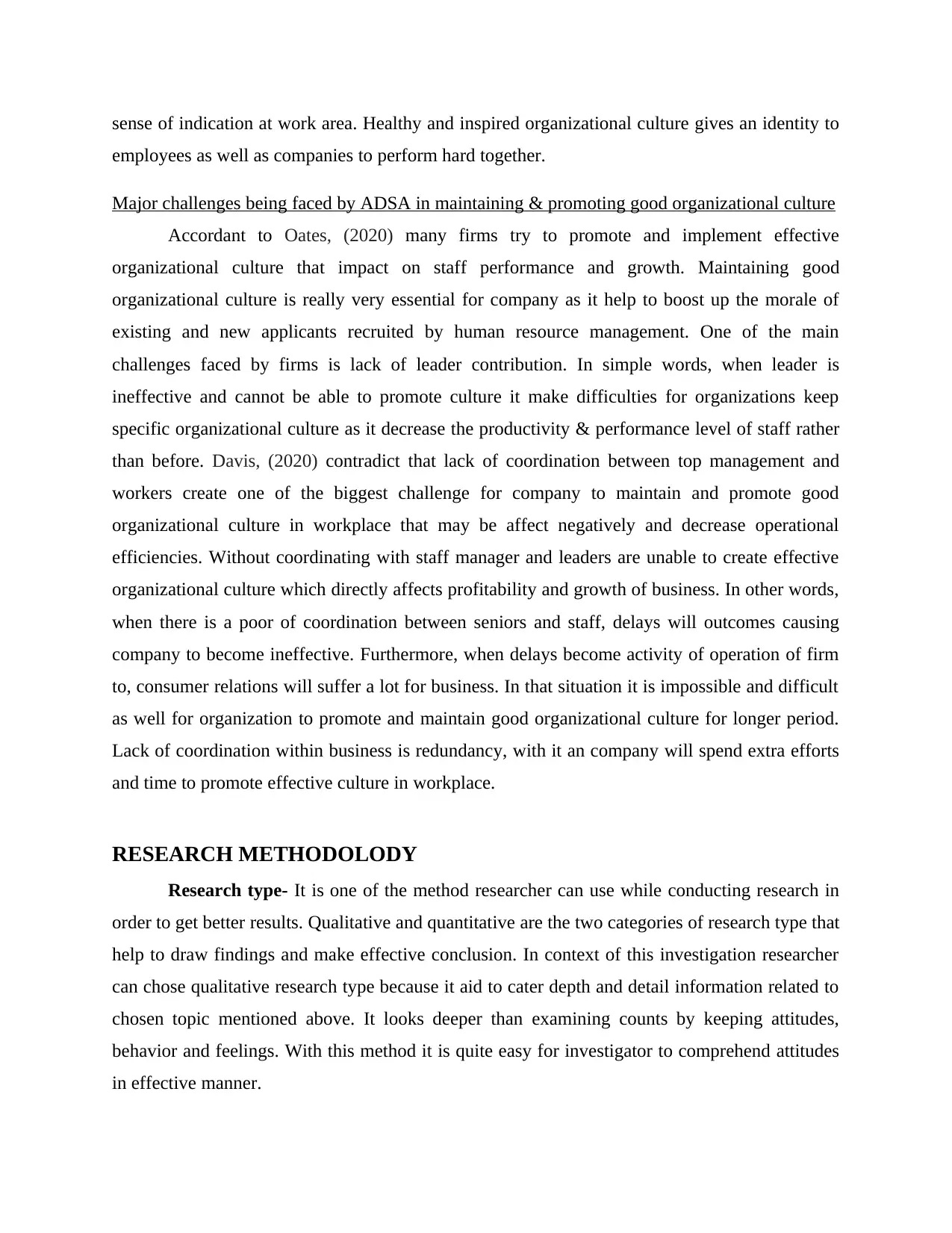
sense of indication at work area. Healthy and inspired organizational culture gives an identity to
employees as well as companies to perform hard together.
Major challenges being faced by ADSA in maintaining & promoting good organizational culture
Accordant to Oates, (2020) many firms try to promote and implement effective
organizational culture that impact on staff performance and growth. Maintaining good
organizational culture is really very essential for company as it help to boost up the morale of
existing and new applicants recruited by human resource management. One of the main
challenges faced by firms is lack of leader contribution. In simple words, when leader is
ineffective and cannot be able to promote culture it make difficulties for organizations keep
specific organizational culture as it decrease the productivity & performance level of staff rather
than before. Davis, (2020) contradict that lack of coordination between top management and
workers create one of the biggest challenge for company to maintain and promote good
organizational culture in workplace that may be affect negatively and decrease operational
efficiencies. Without coordinating with staff manager and leaders are unable to create effective
organizational culture which directly affects profitability and growth of business. In other words,
when there is a poor of coordination between seniors and staff, delays will outcomes causing
company to become ineffective. Furthermore, when delays become activity of operation of firm
to, consumer relations will suffer a lot for business. In that situation it is impossible and difficult
as well for organization to promote and maintain good organizational culture for longer period.
Lack of coordination within business is redundancy, with it an company will spend extra efforts
and time to promote effective culture in workplace.
RESEARCH METHODOLODY
Research type- It is one of the method researcher can use while conducting research in
order to get better results. Qualitative and quantitative are the two categories of research type that
help to draw findings and make effective conclusion. In context of this investigation researcher
can chose qualitative research type because it aid to cater depth and detail information related to
chosen topic mentioned above. It looks deeper than examining counts by keeping attitudes,
behavior and feelings. With this method it is quite easy for investigator to comprehend attitudes
in effective manner.
employees as well as companies to perform hard together.
Major challenges being faced by ADSA in maintaining & promoting good organizational culture
Accordant to Oates, (2020) many firms try to promote and implement effective
organizational culture that impact on staff performance and growth. Maintaining good
organizational culture is really very essential for company as it help to boost up the morale of
existing and new applicants recruited by human resource management. One of the main
challenges faced by firms is lack of leader contribution. In simple words, when leader is
ineffective and cannot be able to promote culture it make difficulties for organizations keep
specific organizational culture as it decrease the productivity & performance level of staff rather
than before. Davis, (2020) contradict that lack of coordination between top management and
workers create one of the biggest challenge for company to maintain and promote good
organizational culture in workplace that may be affect negatively and decrease operational
efficiencies. Without coordinating with staff manager and leaders are unable to create effective
organizational culture which directly affects profitability and growth of business. In other words,
when there is a poor of coordination between seniors and staff, delays will outcomes causing
company to become ineffective. Furthermore, when delays become activity of operation of firm
to, consumer relations will suffer a lot for business. In that situation it is impossible and difficult
as well for organization to promote and maintain good organizational culture for longer period.
Lack of coordination within business is redundancy, with it an company will spend extra efforts
and time to promote effective culture in workplace.
RESEARCH METHODOLODY
Research type- It is one of the method researcher can use while conducting research in
order to get better results. Qualitative and quantitative are the two categories of research type that
help to draw findings and make effective conclusion. In context of this investigation researcher
can chose qualitative research type because it aid to cater depth and detail information related to
chosen topic mentioned above. It looks deeper than examining counts by keeping attitudes,
behavior and feelings. With this method it is quite easy for investigator to comprehend attitudes
in effective manner.
⊘ This is a preview!⊘
Do you want full access?
Subscribe today to unlock all pages.

Trusted by 1+ million students worldwide
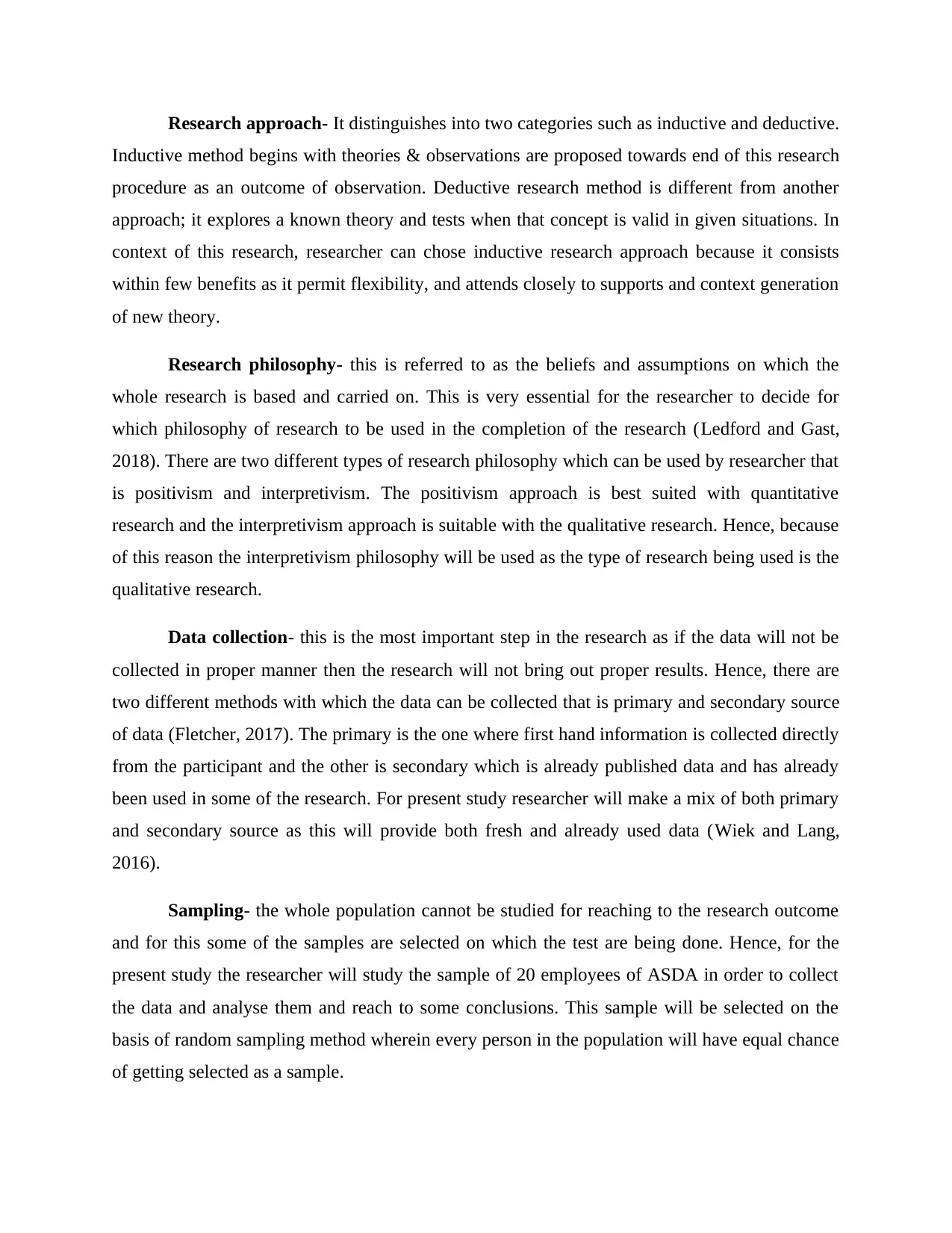
Research approach- It distinguishes into two categories such as inductive and deductive.
Inductive method begins with theories & observations are proposed towards end of this research
procedure as an outcome of observation. Deductive research method is different from another
approach; it explores a known theory and tests when that concept is valid in given situations. In
context of this research, researcher can chose inductive research approach because it consists
within few benefits as it permit flexibility, and attends closely to supports and context generation
of new theory.
Research philosophy- this is referred to as the beliefs and assumptions on which the
whole research is based and carried on. This is very essential for the researcher to decide for
which philosophy of research to be used in the completion of the research (Ledford and Gast,
2018). There are two different types of research philosophy which can be used by researcher that
is positivism and interpretivism. The positivism approach is best suited with quantitative
research and the interpretivism approach is suitable with the qualitative research. Hence, because
of this reason the interpretivism philosophy will be used as the type of research being used is the
qualitative research.
Data collection- this is the most important step in the research as if the data will not be
collected in proper manner then the research will not bring out proper results. Hence, there are
two different methods with which the data can be collected that is primary and secondary source
of data (Fletcher, 2017). The primary is the one where first hand information is collected directly
from the participant and the other is secondary which is already published data and has already
been used in some of the research. For present study researcher will make a mix of both primary
and secondary source as this will provide both fresh and already used data (Wiek and Lang,
2016).
Sampling- the whole population cannot be studied for reaching to the research outcome
and for this some of the samples are selected on which the test are being done. Hence, for the
present study the researcher will study the sample of 20 employees of ASDA in order to collect
the data and analyse them and reach to some conclusions. This sample will be selected on the
basis of random sampling method wherein every person in the population will have equal chance
of getting selected as a sample.
Inductive method begins with theories & observations are proposed towards end of this research
procedure as an outcome of observation. Deductive research method is different from another
approach; it explores a known theory and tests when that concept is valid in given situations. In
context of this research, researcher can chose inductive research approach because it consists
within few benefits as it permit flexibility, and attends closely to supports and context generation
of new theory.
Research philosophy- this is referred to as the beliefs and assumptions on which the
whole research is based and carried on. This is very essential for the researcher to decide for
which philosophy of research to be used in the completion of the research (Ledford and Gast,
2018). There are two different types of research philosophy which can be used by researcher that
is positivism and interpretivism. The positivism approach is best suited with quantitative
research and the interpretivism approach is suitable with the qualitative research. Hence, because
of this reason the interpretivism philosophy will be used as the type of research being used is the
qualitative research.
Data collection- this is the most important step in the research as if the data will not be
collected in proper manner then the research will not bring out proper results. Hence, there are
two different methods with which the data can be collected that is primary and secondary source
of data (Fletcher, 2017). The primary is the one where first hand information is collected directly
from the participant and the other is secondary which is already published data and has already
been used in some of the research. For present study researcher will make a mix of both primary
and secondary source as this will provide both fresh and already used data (Wiek and Lang,
2016).
Sampling- the whole population cannot be studied for reaching to the research outcome
and for this some of the samples are selected on which the test are being done. Hence, for the
present study the researcher will study the sample of 20 employees of ASDA in order to collect
the data and analyse them and reach to some conclusions. This sample will be selected on the
basis of random sampling method wherein every person in the population will have equal chance
of getting selected as a sample.
Paraphrase This Document
Need a fresh take? Get an instant paraphrase of this document with our AI Paraphraser
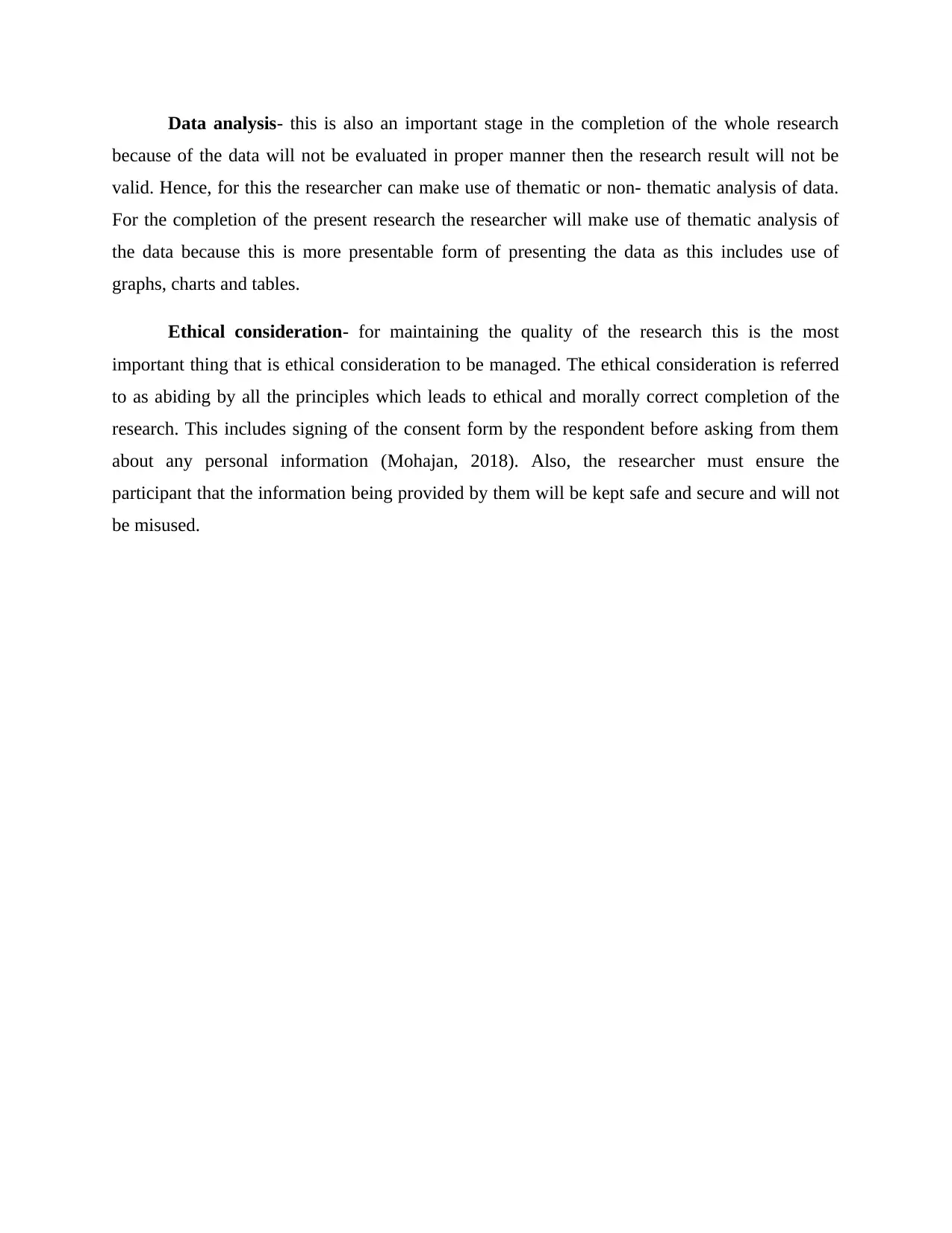
Data analysis- this is also an important stage in the completion of the whole research
because of the data will not be evaluated in proper manner then the research result will not be
valid. Hence, for this the researcher can make use of thematic or non- thematic analysis of data.
For the completion of the present research the researcher will make use of thematic analysis of
the data because this is more presentable form of presenting the data as this includes use of
graphs, charts and tables.
Ethical consideration- for maintaining the quality of the research this is the most
important thing that is ethical consideration to be managed. The ethical consideration is referred
to as abiding by all the principles which leads to ethical and morally correct completion of the
research. This includes signing of the consent form by the respondent before asking from them
about any personal information (Mohajan, 2018). Also, the researcher must ensure the
participant that the information being provided by them will be kept safe and secure and will not
be misused.
because of the data will not be evaluated in proper manner then the research result will not be
valid. Hence, for this the researcher can make use of thematic or non- thematic analysis of data.
For the completion of the present research the researcher will make use of thematic analysis of
the data because this is more presentable form of presenting the data as this includes use of
graphs, charts and tables.
Ethical consideration- for maintaining the quality of the research this is the most
important thing that is ethical consideration to be managed. The ethical consideration is referred
to as abiding by all the principles which leads to ethical and morally correct completion of the
research. This includes signing of the consent form by the respondent before asking from them
about any personal information (Mohajan, 2018). Also, the researcher must ensure the
participant that the information being provided by them will be kept safe and secure and will not
be misused.
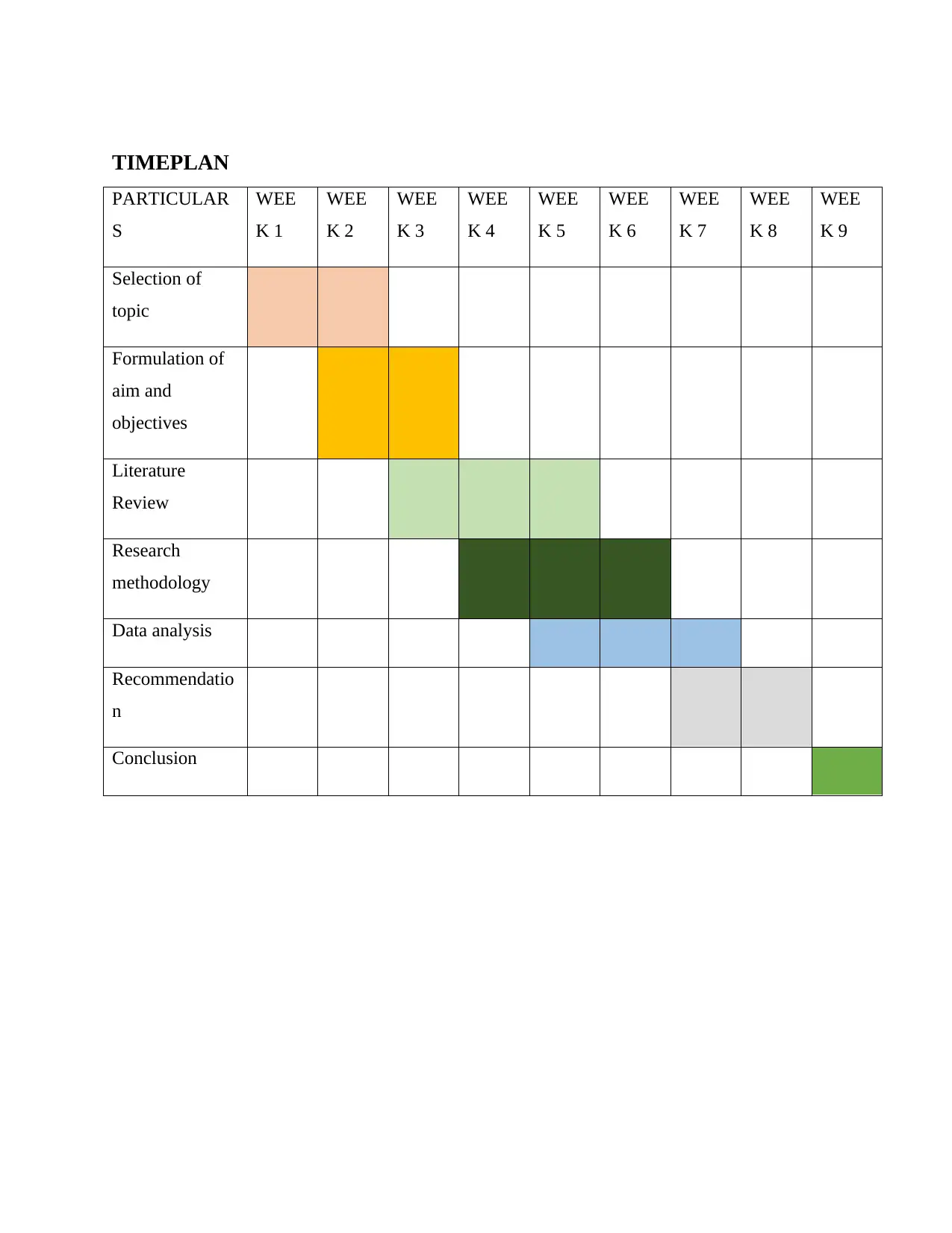
TIMEPLAN
PARTICULAR
S
WEE
K 1
WEE
K 2
WEE
K 3
WEE
K 4
WEE
K 5
WEE
K 6
WEE
K 7
WEE
K 8
WEE
K 9
Selection of
topic
Formulation of
aim and
objectives
Literature
Review
Research
methodology
Data analysis
Recommendatio
n
Conclusion
PARTICULAR
S
WEE
K 1
WEE
K 2
WEE
K 3
WEE
K 4
WEE
K 5
WEE
K 6
WEE
K 7
WEE
K 8
WEE
K 9
Selection of
topic
Formulation of
aim and
objectives
Literature
Review
Research
methodology
Data analysis
Recommendatio
n
Conclusion
⊘ This is a preview!⊘
Do you want full access?
Subscribe today to unlock all pages.

Trusted by 1+ million students worldwide
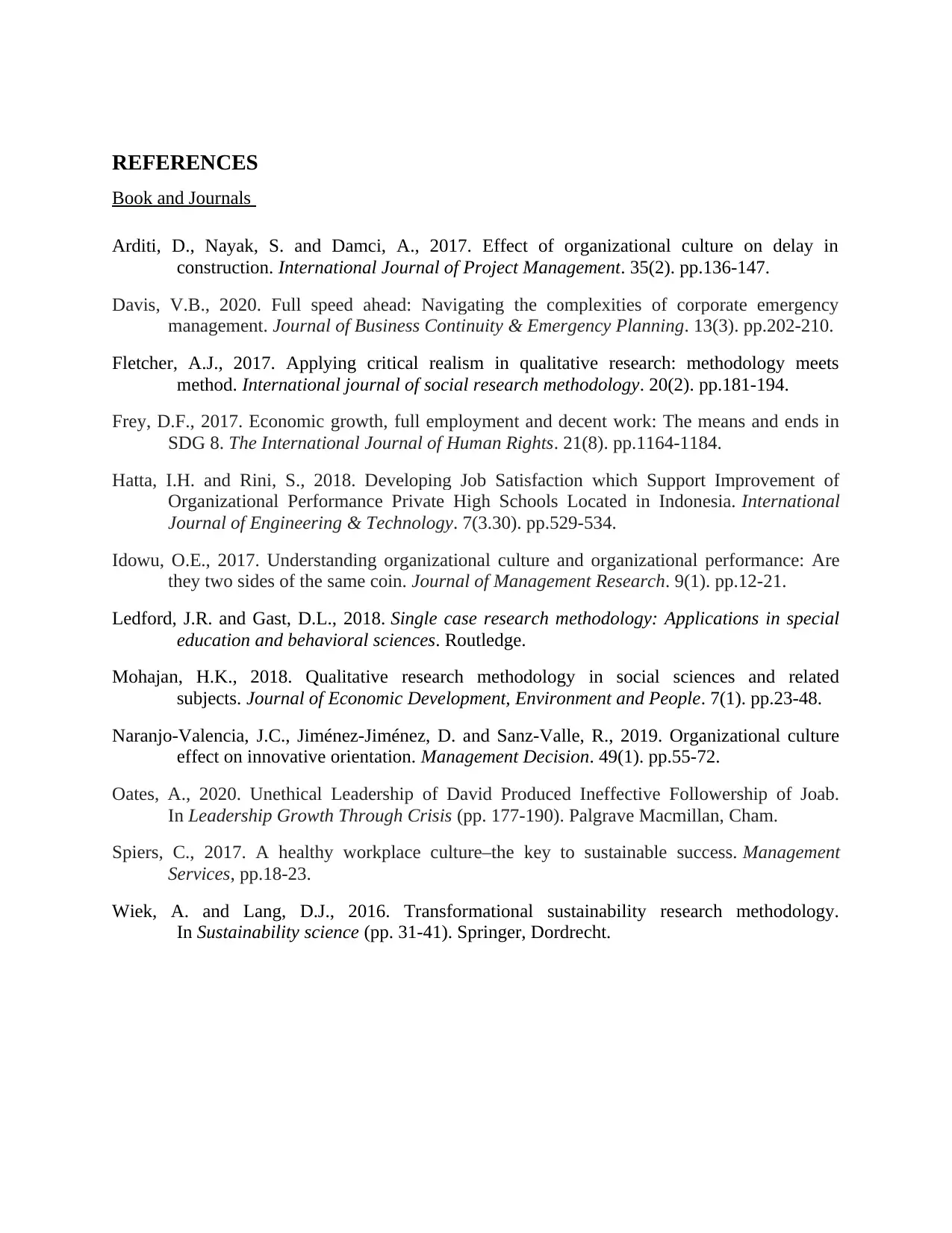
REFERENCES
Book and Journals
Arditi, D., Nayak, S. and Damci, A., 2017. Effect of organizational culture on delay in
construction. International Journal of Project Management. 35(2). pp.136-147.
Davis, V.B., 2020. Full speed ahead: Navigating the complexities of corporate emergency
management. Journal of Business Continuity & Emergency Planning. 13(3). pp.202-210.
Fletcher, A.J., 2017. Applying critical realism in qualitative research: methodology meets
method. International journal of social research methodology. 20(2). pp.181-194.
Frey, D.F., 2017. Economic growth, full employment and decent work: The means and ends in
SDG 8. The International Journal of Human Rights. 21(8). pp.1164-1184.
Hatta, I.H. and Rini, S., 2018. Developing Job Satisfaction which Support Improvement of
Organizational Performance Private High Schools Located in Indonesia. International
Journal of Engineering & Technology. 7(3.30). pp.529-534.
Idowu, O.E., 2017. Understanding organizational culture and organizational performance: Are
they two sides of the same coin. Journal of Management Research. 9(1). pp.12-21.
Ledford, J.R. and Gast, D.L., 2018. Single case research methodology: Applications in special
education and behavioral sciences. Routledge.
Mohajan, H.K., 2018. Qualitative research methodology in social sciences and related
subjects. Journal of Economic Development, Environment and People. 7(1). pp.23-48.
Naranjo-Valencia, J.C., Jiménez-Jiménez, D. and Sanz-Valle, R., 2019. Organizational culture
effect on innovative orientation. Management Decision. 49(1). pp.55-72.
Oates, A., 2020. Unethical Leadership of David Produced Ineffective Followership of Joab.
In Leadership Growth Through Crisis (pp. 177-190). Palgrave Macmillan, Cham.
Spiers, C., 2017. A healthy workplace culture–the key to sustainable success. Management
Services, pp.18-23.
Wiek, A. and Lang, D.J., 2016. Transformational sustainability research methodology.
In Sustainability science (pp. 31-41). Springer, Dordrecht.
Book and Journals
Arditi, D., Nayak, S. and Damci, A., 2017. Effect of organizational culture on delay in
construction. International Journal of Project Management. 35(2). pp.136-147.
Davis, V.B., 2020. Full speed ahead: Navigating the complexities of corporate emergency
management. Journal of Business Continuity & Emergency Planning. 13(3). pp.202-210.
Fletcher, A.J., 2017. Applying critical realism in qualitative research: methodology meets
method. International journal of social research methodology. 20(2). pp.181-194.
Frey, D.F., 2017. Economic growth, full employment and decent work: The means and ends in
SDG 8. The International Journal of Human Rights. 21(8). pp.1164-1184.
Hatta, I.H. and Rini, S., 2018. Developing Job Satisfaction which Support Improvement of
Organizational Performance Private High Schools Located in Indonesia. International
Journal of Engineering & Technology. 7(3.30). pp.529-534.
Idowu, O.E., 2017. Understanding organizational culture and organizational performance: Are
they two sides of the same coin. Journal of Management Research. 9(1). pp.12-21.
Ledford, J.R. and Gast, D.L., 2018. Single case research methodology: Applications in special
education and behavioral sciences. Routledge.
Mohajan, H.K., 2018. Qualitative research methodology in social sciences and related
subjects. Journal of Economic Development, Environment and People. 7(1). pp.23-48.
Naranjo-Valencia, J.C., Jiménez-Jiménez, D. and Sanz-Valle, R., 2019. Organizational culture
effect on innovative orientation. Management Decision. 49(1). pp.55-72.
Oates, A., 2020. Unethical Leadership of David Produced Ineffective Followership of Joab.
In Leadership Growth Through Crisis (pp. 177-190). Palgrave Macmillan, Cham.
Spiers, C., 2017. A healthy workplace culture–the key to sustainable success. Management
Services, pp.18-23.
Wiek, A. and Lang, D.J., 2016. Transformational sustainability research methodology.
In Sustainability science (pp. 31-41). Springer, Dordrecht.
1 out of 10
Related Documents
Your All-in-One AI-Powered Toolkit for Academic Success.
+13062052269
info@desklib.com
Available 24*7 on WhatsApp / Email
![[object Object]](/_next/static/media/star-bottom.7253800d.svg)
Unlock your academic potential
Copyright © 2020–2025 A2Z Services. All Rights Reserved. Developed and managed by ZUCOL.





